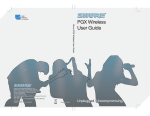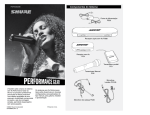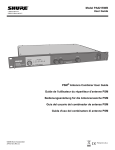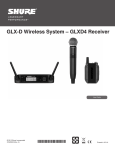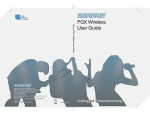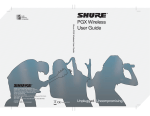Download Shure PGXD User guide
Transcript
PGXD Wireless System Shure PGXD Wireless PGXD sans fil de Shure Shure PGXD Sem Fio ©2010 Shure Incorporated 27B14513 (Rev. 2) Printed in U.S.A. D D D D D D D D PGXD System Components PGX Digital Wireless Systems Offering uniquely tailored wireless solutions for vocalists, guitarists, and presenters, PGX-Digital combines the trusted legacy of Shure wired microphones with state-of-the-art, 24-bit digital wireless technology to deliver strong, clean RF performance. The result is wireless audio that sounds like wired, rock-steady RF signal even at extended distances, and plug-and-play setup and operation. • Professional quality 24-bit digital audio • Digital RF technology for rock-solid performance • Wide variety of rugged and dependable Shure microphones • One-touch setup and operation • Up to 10 hours of battery life (9 hours, PGXD2) • Up to 200 foot range (line-of-sight) • 900 MHz operation—free from white spaces or DTV interference All systems include • PGXD4 receiver • 2 AA alkaline batteries • Power supply • User guide Vocalist systems include • PGXD2 handheld transmitter • Microphone head (choice of PG58, SM58®, SM86, Beta 58A® or Beta 87A*) • Microphone clip * Available only in select markets Lavalier, Headworn, and Instrument systems include • PGXD1 bodypack transmitter • Microphone (choice of WL93, WL185, PG30 or Beta 98H/C) Guitar systems include • PGXD1 bodypack transmitter • 1/4” to mini 4-pin guitar cable (WA302) Receiver Controls and Connectors PGXD4 ① audio LED Indicates strength of incoming audio signal: green for normal, amber for strong and red for clipping. ⑤ Infrared (IR) port Sends IR signal to transmitter for sync. ② LED Screen Displays group and channel setting. See “Single System Setup” for details. ③ channel button Changes group and channel setting. See “Single System Setup” for details. ⑥ sync button Press to synchronize transmitter with receiver group and channel settings. ④ ready LED Indicates system ready and receiving an RF signal from the transmitter. Also indicates battery level of the transmitter: • Green = transmitter battery level normal • Red = low battery (typically less than 60 minutes with alkaline batteries) Note: with NiMH rechargeable batteries, when the indicator turns red there will be little to no remaining life. 1 ⑧ Adapter cord tie-off ⑩ 6.35 mm (1/4”) instrument level output jack MIC ⑦ AC adapter jack INSTRUMENT ⑨ XLR microphone output jack Transmitter Controls and Connectors PGXD2 ① Indicator LED Displays battery level, mute, and IR transmission status (see table). ② Power / Mute Switch Press to mute or unmute. Press and hold to power on or off. ③ Infrared (IR) port Receives infrared beam to synchronize frequencies. When using multiple systems, only one transmitter IR port should be exposed at a time. PGXD PGXD BIAS ④ 4-Pin Microphone Input Jack AUDIO 0dB ⑤ Audio Gain Adjustment Transmitter Indicator LED 2 LED Indicator Status Green Ready Flashing green Controls locked Amber Mute on Solid red Battery power low Flashing red Batteries dead (change batteries to power on transmitter) Rapidly flashing red IR transmission in process Flashing amber and red Battery power low and mute on PGXD1 -10dB Batteries Wearing the Bodypack Transmitter • A fresh set of alkaline batteries lasts up to 10 hours (9 hours, PGXD2). Clip the transmitter to a belt or slide a guitar strap through the transmitter clip as shown. • The transmitter LED and the receiver ready LED glow red to indicate low battery (typically less than 60 minutes remaining). For best results, slide the transmitter until the belt is pressed against the base of the clip. • NiMH rechargeable batteries may be used. However, the low battery indicator functions differently. When it turns red, there may be little to no remaining life. • When the LED flashes red, the batteries must be replaced to power on the transmitter. PGXD Adjusting Gain For best audio quality, set transmitter gain so the audio LED on the receiver flickers green and amber during the performance. Decrease gain if the signal clips (LED turns red). Note: The amber LED may appear to be red when viewed at an angle. For best results, monitor the LED from directly in front. Bodypack Transmitter Handheld Transmitter • Increase gain (clockwise +) for microphones Use the tip of a pen or a small screwdriver to move the switch. The bodypack has 26 dB of audio gain adjustment. • Decrease gain (counterclockwise –) for guitars or high-output instruments Access the gain switch by unscrewing the head of the microphone. • 0dB: For quiet to normal vocal performance. • –10dB: Use only if audio is distorted due to high vocal levels. BIAS AUDIO 0dB -10dB PGXD AUDIO 0dB -10dB 3 Single System Setup Synchronize Scan Synchronize the transmitter to the receiver by aligning the infrared (IR) ports and pressing the sync button. Make sure the IR ports are closely aligned. Use the scan feature on the receiver to find a clear channel. After a successful sync, the transmitter LED momentarily flashes red and the receiver ready light illuminates. LED screen displays current channel channel press channel button to scan for a clear channel NOTE: This wireless system may be affected by RF interference when used in proximity to other wireless devices such as cordless phones, baby monitors, and two-way radios. For best results, use the scan and sync feature before each use or if you experience problems. system scans for the channel with the least interference Multiple System Setup Use the following steps to ensure the best performance when installing multiple wireless systems at the same location. 1. Turn all receivers on and all transmitters off. Note: Turn on any other digital equipment that could cause interference during the performance so it will be detected during the frequency scans in the following steps. 2. Make sure the group number is the same for all receivers (see Manual Group Selection). 3. Perform a scan using the first receiver. 4. Turn on the first transmitter and sync it to the receiver. 5. Repeat for each system. • Important: After syncing each transmitter, leave it on so that scans from the other receivers will not select that channel. • Be sure only one transmitter IR port is exposed when synchronizing each system. Compatible Frequencies When operating multiple systems simultaneously, choose one group from the following table and set all systems to different channels within that group. 4 Number of Systems Group (by band) X8 X8A (Austrailia) X8B (Brazil) 2 3 to 9 3 to 9 3 to 9 3 3 to 9 3 to 9 3 to 9 4 3 to 9 -- 3 to 9 5 7 to 9 -- -- Manual Channel and Group Selection (receiver only) Using the receiver to scan for a channel is the best way to find the best frequency for your system. However, for multiple system setup, you may need to manually set the group number. 1. Press and hold the channel button. 2. Hold the button until the channel or group display begins flashing. 3. Release and press the button again to advance the setting. At the desired channel or group number, wait for the flashing to stop. This activates the new setting. 4. Transfer the new frequency setting to the transmitter using the automatic sync function. channel group display select channel channel display 3s select channel channel channel channel 6s channel channel channel channel Locking and Unlocking Controls Locking the system controls prevents accidental muting or channel adjustment during performances. Transmitter To lock the controls: With the transmitter off, hold the power button down until the green LED flashes (~5 seconds) To unlock the controls: With the transmitter on, hold the power button down until the green LED flashes (~5 seconds) Receiver To lock the channel: Hold the channel button until the numbers flash (~10 seconds) To unlock the channel: Hold the channel button until the numbers flash (~5 seconds) 5 Troubleshooting Issue Indicator Status Solution No sound or faint sound Receiver ready LED on Verify all sound system connections Receiver ready LED off • Turn on transmitter • Make sure the batteries are installed correctly • Perform automatic transmitter setup • Insert fresh batteries Noise bursts or audio dropouts Receiver LED screen off Make sure AC adapter is securely plugged into electrical outlet Transmitter indicator LED flashing red Replace transmitter batteries. LED screen shows dash and value Error code displayed. Contact your Shure reseller for assistance. Transmitter LED flashes red for 7 seconds after attempting to sync Transmitter and receiver incompatible. Contact your Shure reseller for assistance. N/A • Change receiver and transmitter to a different channel • Remove nearby sources of RF interference such as cordless or cell phones, computers, wireless routers, media players, digital signal processors, and security systems. • Replace transmitter batteries • If using multiple systems, change the frequency of one of the active systems Distortion Audio LED on receiver indicates clipping (red) Reduce transmitter gain Distortion increases gradually over time Transmitter power light glowing or flashing red Replace transmitter batteries Sound level different from cabled guitar or microphone or when using different guitars N/A Adjust transmitter gain as necessary Cannot turn transmitter on Transmitter LED slowly flashing red Replace transmitter batteries Transmitter LED rapidly flashing red Contact your Shure reseller for assistance. 1/4” Output XLR Output 50 ohms 50 ohms 6 50 ohms 50 ohms SPECIFICATIONS Working Range (Line of Sight) 60 m (200 ft) Note: Actual range depends on RF signal absorption, reflection and interference. RF Carrier Range X8: 902–928 MHz X8A: 915–928 MHz X8B: 902–907.5 MHz, 915–928 MHz Note: varies by region Audio Frequency Response 20–20000 Hz Note: Dependent on microphone type Total Harmonic Distortion (Ref. 1 kHz, 6 dB below input clip) <0.02%, A-weighted, typical Dynamic Range >108 dB, A-weighted Operating Temperature Range -18°C (0°F)– +50°C (122°F) Note: Battery characteristics may limit this range. Transmitter Audio Polarity Positive pressure on microphone diaphragm (or positive voltage applied to tip of WA302 phone plug) produces positive voltage on pin 2 (with respect to pin 3 of low-impedance output) and the tip of the high impedance 1/4-inch output. PGXD1 Bodypack Transmitter Audio Input Level +10 dBV maximum, at minimum gain setting -16 dBV maximum, at maximum gain setting Gain Adjustment Range 26 dB Input Impedance 1 MΩ RF Output Power 10 mW varies by region Pin Assignments TA4M: 1: ground (cable shield) 2: + 5 V Bias 3: audio 4: Tied through active load to ground (On instrument adapter cable, pin 4 floats) Dimensions 108 mm x 64 mm x 19 mm (H x W x D) Weight 128 g (4.5 oz.)(without batteries) Housing Molded polycarbonate case Power Requirements 2 “AA” size alkaline or rechargeable batteries Battery Life up to 10 hours PGXD2 Handheld Transmitter Audio Input Level +5 dBV maximum at -10 dB gain position –5 dBV maximum at 0 dB gain position Gain Adjustment Range 10 dB RF Output Power 10 mW varies by region Dimensions 254 mm X 51 mm dia. (10 X 2 in.) Weight 349 g (12.3 oz.) (without batteries) Housing Molded PC/ABS handle and battery cup Power Requirements 2 “AA” size alkaline or rechargeable batteries Battery Life up to 9 hours PGXD4 Wireless Receiver Dimensions 40 mm X 181 mm X 104 mm (H x W x D) Weight 289 g (10.2 oz.) Housing ABS Sensitivity -102 dBm @ 10-5 BER Power Requirements 12–18 V DC @ 150 mA, supplied by external power supply (tip positive) Audio LED Red: 2 dB below clip Amber: 12 dB below clip Green: 50 dB below clip Audio Output Configuration Impedance balanced Audio Output Level (1 kHz tone) XLR connector: –2.5 dBV (into 3 kΩ load) 6.35 mm (1/4”) connector: +10 dBV (into 10 kΩ load) Impedance XLR: 50 Ω 6.35 mm (1/4”): 50 Ω Pin Assignments XLR: 1=ground, 2=hot, 3=cold 6.35 mm (1/4”) TRS: Tip=audio, Ring=no audio, Sleeve=ground 7 CERTIFICATION PGXD1, PGXD2, PGXD4 This Class B digital apparatus complies with Canadian ICES-003. Cet appareil numérique de la classe B est conforme à la norme NMB-003 du Canada. Certified by IC in Canada under RSS-210 and RSS-102. (IC: 616A-PGXD1, 616A-PGXD2, 616A-PGXD4). PGXD1, PGXD2 Certified under FCC Part 15. (FCC ID: DD4PGXD1, DD4PGXD2). PGXD4 Approved under the Declaration of Conformity (DoC) provision of FCC Part 15. Operation of this device is subject to the following two conditions: (1) this device may not cause interference, and (2) this device must accept any interference, including interference that may cause undesired operation of the device. LICENSING INFORMATION Licensing: A ministerial license to operate this equipment may be required in certain areas. Consult your national authority for possible requirements. Changes or modifications not expressly approved by Shure Incorporated could void your authority to operate the equipment. Licensing of Shure wireless microphone equipment is the user’s responsibility, and licensability depends on the user’s classification and application, and on the selected frequency. Shure strongly urges the user to contact the appropriate telecommunications authority concerning proper licensing, and before choosing and ordering frequencies. INFORMATION TO USER This equipment has been tested and found to comply with the limits for a Class B digital device, pursuant to Part 15 of the FCC Rules. These limits are designed to provide reasonable protection against harmful interference in a residential installation. This equipment generates, uses and can radiate radio frequency energy and, if not installed and used in accordance with the instructions, may cause harmful interference to radio communications. However, there is no guarantee that interference will not occur in a particular installation. If this equipment does cause harmful interference to radio or television reception, which can be determined by turning the equipment off and on, the user is encouraged to try to correct the interference by one or more of the following measures: • Relocate the receiving antenna. • Increase the separation between the equipment and receiver. • Connect the equipment into an outlet on a circuit different from that to which the receiver is connected. • Consult the dealer. Note: EMC conformance testing is based on the use of supplied and recommended cable types. The use of other cable types may degrade EMC performance. Changes or modifications not expressly approved by the manufacturer could void the user’s authority to operate the equipment. 1/4” Output XLR Output 50 ohms 50 ohms 8 50 ohms 50 ohms Middle East, Africa: East, Africa: MiddleEurope, East, Africa: Latin MiddleEurope, United States,United Canada, Latin United States, Canada,States, Latin Canada, Europe, Asia, Pacific: Asia, Pacific: Asia, Pacific: Shure Europe GmbH Shure Asia Limited Shure Europe GmbH Shure Europe GmbH America, Caribbean: Shure Asia Limited America, Caribbean: America, Caribbean: Shure Asia Limited Wannenäckestr. 28, 22/F, 625 King’s Wannenäckestr. Wannenäckestr. 28, 28, Shure Incorporated 22/F, 625 King’s Road Shure Incorporated Shure Incorporated 22/F, Road 625 King’s Road 74078 Heilbronn, Germany 74078 Germany Heilbronn, Germany 5800 West Touhy Avenue74078 Heilbronn, NorthEast Point, Island East 5800 West Touhy Avenue 5800 West Touhy Avenue North Point, Island NorthEast Point, Island Hong Kong Niles,USA IL 60714-4608 USA Hong Kong Hong Kong Niles, IL 60714-4608 Niles,USA IL 60714-4608 Phone: 49-7131-72140 Phone: 49-7131-72140 Phone: 49-7131-72140 Phone: 847-600-2000 Phone: 847-600-2000 Phone: 847-600-2000 Phone: 852-2893-4290 Phone: 852-2893-4290 Phone: 852-2893-4290 Fax: 49-7131-721414 Fax: 49-7131-721414 Fax:(USA) 847-600-1212 (USA) Fax: 49-7131-721414 Fax: 847-600-1212 Fax:(USA) 847-600-1212 Fax: 852-2893-4055 Fax: 852-2893-4055 Fax: 852-2893-4055 Email: [email protected] Email: [email protected] Email: [email protected] Fax: 847-600-6446 Fax: 847-600-6446 Fax: 847-600-6446 Email: [email protected] Email: [email protected] Email: [email protected] Email: [email protected] Email: [email protected] Email: [email protected] www.shure.com www.shure.com www.shure.com ©2010 Shure Incorporated ©2010 Shure Incorporated ©2010 Shure Incorporated






















